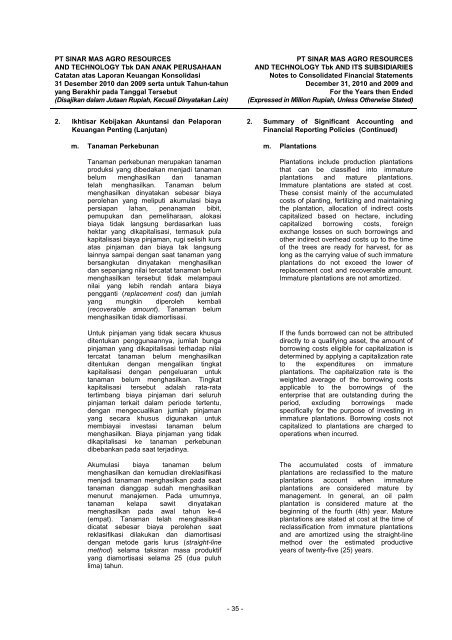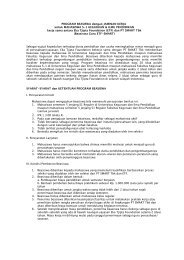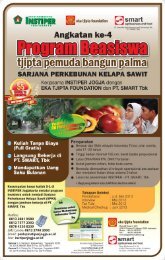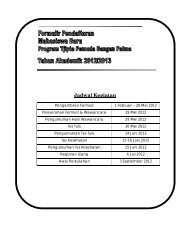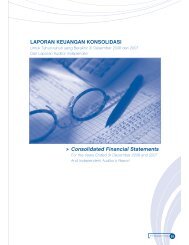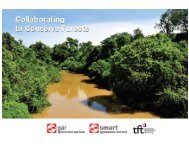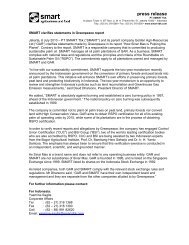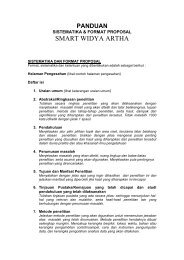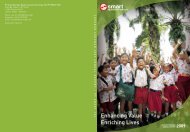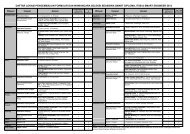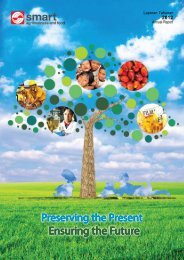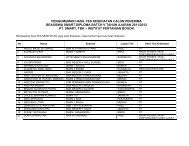Annual Report - PT SMART Tbk
Annual Report - PT SMART Tbk
Annual Report - PT SMART Tbk
- No tags were found...
Create successful ePaper yourself
Turn your PDF publications into a flip-book with our unique Google optimized e-Paper software.
<strong>PT</strong> SINAR MAS AGRO RESOURCESAND TECHNOLOGY <strong>Tbk</strong> DAN ANAK PERUSAHAANCatatan atas Laporan Keuangan Konsolidasi31 Desember 2010 dan 2009 serta untuk Tahun-tahunyang Berakhir pada Tanggal Tersebut(Disajikan dalam Jutaan Rupiah, Kecuali Dinyatakan Lain)<strong>PT</strong> SINAR MAS AGRO RESOURCESAND TECHNOLOGY <strong>Tbk</strong> AND ITS SUBSIDIARIESNotes to Consolidated Financial StatementsDecember 31, 2010 and 2009 andFor the Years then Ended(Expressed in Million Rupiah, Unless Otherwise Stated)2. Ikhtisar Kebijakan Akuntansi dan PelaporanKeuangan Penting (Lanjutan)2. Summary of Significant Accounting andFinancial <strong>Report</strong>ing Policies (Continued)m. Tanaman Perkebunan m. PlantationsTanaman perkebunan merupakan tanamanproduksi yang dibedakan menjadi tanamanbelum menghasilkan dan tanamantelah menghasilkan. Tanaman belummenghasilkan dinyatakan sebesar biayaperolehan yang meliputi akumulasi biayapersiapan lahan, penanaman bibit,pemupukan dan pemeliharaan, alokasibiaya tidak langsung berdasarkan luashektar yang dikapitalisasi, termasuk pulakapitalisasi biaya pinjaman, rugi selisih kursatas pinjaman dan biaya tak langsunglainnya sampai dengan saat tanaman yangbersangkutan dinyatakan menghasilkandan sepanjang nilai tercatat tanaman belummenghasilkan tersebut tidak melampauinilai yang lebih rendah antara biayapengganti (replacement cost) dan jumlahyang mungkin diperoleh kembali(recoverable amount). Tanaman belummenghasilkan tidak diamortisasi.Untuk pinjaman yang tidak secara khususditentukan penggunaannya, jumlah bungapinjaman yang dikapitalisasi terhadap nilaitercatat tanaman belum menghasilkanditentukan dengan mengalikan tingkatkapitalisasi dengan pengeluaran untuktanaman belum menghasilkan. Tingkatkapitalisasi tersebut adalah rata-ratatertimbang biaya pinjaman dari seluruhpinjaman terkait dalam periode tertentu,dengan mengecualikan jumlah pinjamanyang secara khusus digunakan untukmembiayai investasi tanaman belummenghasilkan. Biaya pinjaman yang tidakdikapitalisasi ke tanaman perkebunandibebankan pada saat terjadinya.Akumulasi biaya tanaman belummenghasilkan dan kemudian direklasifikasimenjadi tanaman menghasilkan pada saattanaman dianggap sudah menghasilkanmenurut manajemen. Pada umumnya,tanaman kelapa sawit dinyatakanmenghasilkan pada awal tahun ke-4(empat). Tanaman telah menghasilkandicatat sebesar biaya perolehan saatreklasifikasi dilakukan dan diamortisasidengan metode garis lurus (straight-linemethod) selama taksiran masa produktifyang diamortisasi selama 25 (dua puluhlima) tahun.Plantations include production plantationsthat can be classified into immatureplantations and mature plantations.Immature plantations are stated at cost.These consist mainly of the accumulatedcosts of planting, fertilizing and maintainingthe plantation, allocation of indirect costscapitalized based on hectare, includingcapitalized borrowing costs, foreignexchange losses on such borrowings andother indirect overhead costs up to the timeof the trees are ready for harvest, for aslong as the carrying value of such immatureplantations do not exceed the lower ofreplacement cost and recoverable amount.Immature plantations are not amortized.If the funds borrowed can not be attributeddirectly to a qualifying asset, the amount ofborrowing costs eligible for capitalization isdetermined by applying a capitalization rateto the expenditures on immatureplantations. The capitalization rate is theweighted average of the borrowing costsapplicable to the borrowings of theenterprise that are outstanding during theperiod, excluding borrowings madespecifically for the purpose of investing inimmature plantations. Borrowing costs notcapitalized to plantations are charged tooperations when incurred.The accumulated costs of immatureplantations are reclassified to the matureplantations account when immatureplantations are considered mature bymanagement. In general, an oil palmplantation is considered mature at thebeginning of the fourth (4th) year. Matureplantations are stated at cost at the time ofreclassification from immature plantationsand are amortized using the straight-linemethod over the estimated productiveyears of twenty-five (25) years.- 35 -


